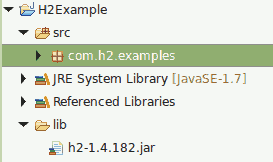H2 In-Memory Database Example

In this H2 In-Memory Database Example, we are going to store the database contents on In-Memory of the system. Here persistence happens on Memory of the system. In this example we are creating a java class that shows how to load the driver, create a database, create table and insert some values into table
H2 is an open source software implementation of Java SQL database. The main features of H2 are.
- Very fast, open source, JDBC API
- Embedded and server modes; in-memory databases
- Browser based Console application
- Small footprint: around 1.5 MB jar file size
Reference -> http://www.h2database.com/html/main.html
Required Libraries
For using H2 database, You need to download
Project Structure

H2 Database Using In-Memory
Here we are showing implementation for SQL Statement and PreparedStatement using H2 In-Memory Database.
In below code you can see that we are using following H2 JDBC URL jdbc:h2:mem:test;DB_CLOSE_DELAY=-1 for connecting the database
By following way, H2 database contents are stored in the memory of the system
import java.sql.Connection;
import java.sql.DriverManager;
import java.sql.PreparedStatement;
import java.sql.ResultSet;
import java.sql.SQLException;
import java.sql.Statement;
// H2 In-Memory Database Example shows about storing the database contents into memory.
public class H2MemoryDatabaseExample {
private static final String DB_DRIVER = "org.h2.Driver";
private static final String DB_CONNECTION = "jdbc:h2:mem:test;DB_CLOSE_DELAY=-1";
private static final String DB_USER = "";
private static final String DB_PASSWORD = "";
public static void main(String[] args) throws Exception {
try {
insertWithStatement();
insertWithPreparedStatement();
} catch (SQLException e) {
e.printStackTrace();
}
}
private static void insertWithPreparedStatement() throws SQLException {
Connection connection = getDBConnection();
PreparedStatement createPreparedStatement = null;
PreparedStatement insertPreparedStatement = null;
PreparedStatement selectPreparedStatement = null;
String CreateQuery = "CREATE TABLE PERSON(id int primary key, name varchar(255))";
String InsertQuery = "INSERT INTO PERSON" + "(id, name) values" + "(?,?)";
String SelectQuery = "select * from PERSON";
try {
connection.setAutoCommit(false);
createPreparedStatement = connection.prepareStatement(CreateQuery);
createPreparedStatement.executeUpdate();
createPreparedStatement.close();
insertPreparedStatement = connection.prepareStatement(InsertQuery);
insertPreparedStatement.setInt(1, 1);
insertPreparedStatement.setString(2, "Jose");
insertPreparedStatement.executeUpdate();
insertPreparedStatement.close();
selectPreparedStatement = connection.prepareStatement(SelectQuery);
ResultSet rs = selectPreparedStatement.executeQuery();
System.out.println("H2 In-Memory Database inserted through PreparedStatement");
while (rs.next()) {
System.out.println("Id " + rs.getInt("id") + " Name " + rs.getString("name"));
}
selectPreparedStatement.close();
connection.commit();
} catch (SQLException e) {
System.out.println("Exception Message " + e.getLocalizedMessage());
} catch (Exception e) {
e.printStackTrace();
} finally {
connection.close();
}
}
private static void insertWithStatement() throws SQLException {
Connection connection = getDBConnection();
Statement stmt = null;
try {
connection.setAutoCommit(false);
stmt = connection.createStatement();
stmt.execute("CREATE TABLE PERSON(id int primary key, name varchar(255))");
stmt.execute("INSERT INTO PERSON(id, name) VALUES(1, 'Anju')");
stmt.execute("INSERT INTO PERSON(id, name) VALUES(2, 'Sonia')");
stmt.execute("INSERT INTO PERSON(id, name) VALUES(3, 'Asha')");
ResultSet rs = stmt.executeQuery("select * from PERSON");
System.out.println("H2 In-Memory Database inserted through Statement");
while (rs.next()) {
System.out.println("Id " + rs.getInt("id") + " Name " + rs.getString("name"));
}
stmt.execute("DROP TABLE PERSON");
stmt.close();
connection.commit();
} catch (SQLException e) {
System.out.println("Exception Message " + e.getLocalizedMessage());
} catch (Exception e) {
e.printStackTrace();
} finally {
connection.close();
}
}
private static Connection getDBConnection() {
Connection dbConnection = null;
try {
Class.forName(DB_DRIVER);
} catch (ClassNotFoundException e) {
System.out.println(e.getMessage());
}
try {
dbConnection = DriverManager.getConnection(DB_CONNECTION, DB_USER, DB_PASSWORD);
return dbConnection;
} catch (SQLException e) {
System.out.println(e.getMessage());
}
return dbConnection;
}
}
Output
H2 In-Memory Database inserted through Statement Id 1 Name Anju Id 2 Name Sonia Id 3 Name Asha H2 In-Memory Database inserted through PreparedStatement Id 1 Name Jose